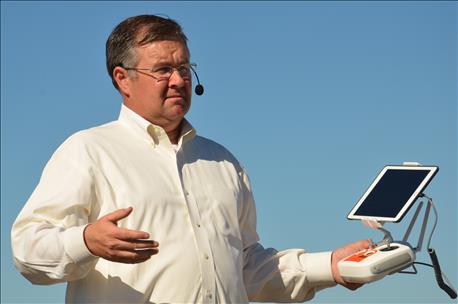
“I’m not going through the hassle of buying a study guide and learning a bunch of silly rules just to fly the drone I bought and paid for. If I want to scout my crops and use the information, I’m going to do it. I don’t need permission from anyone.”
Hopefully that’s not your attitude. If you know someone who talks that way, Chad Colby hopes you will convince them they’re on the wrong track. The Federal Aviation Administration has finally put regulations in place that allow farmers and others to use unmanned aerial vehicles for commercial purposes in agriculture legally.

FOLLOW THE RULES: Chad Colby says the opportunity people have been waiting for to use UAVs in agriculture legally is finally here.
“Two years ago we dreamed about having this opportunity,” says Colby, general manager of Central Illinois Ag, a Case IH dealer near Atlanta, Ill. One of his concerns is that if people ignore the rules and tragedies happen, the FAA will have no choice but to impose stricter rules.
Strict but fair
Any farmer who also pilots his or her own small plane will tell you the FAA is serious when it comes to controlling the airspace, and rightfully so. Rules are in place so everyone can share the airspace safely.
There were naysayers who predicted the FAA would not allow drones to be used commercially in agriculture. As recently as two years ago at major meetings, various speakers cast doubt on FAA’s rule-making process.
Despite all that, the agency moved forward and developed rules, just as it said it would. Since the end of August, the rules have been in place.
Most of the rules are straightforward. For example, you can’t fly higher than 400 feet, and you must always have visual contact with the drone.
UAVs must be registered with the FAA, and you must have an operator’s certificate to fly one. “The test is straightforward if you prepare properly,” Colby says. “There are certain things you need to know about flying a UAV, and that means studying and learning before you just start flying. If you prepare properly, you should be able to pass the test.”
Attitude matters
Colby compares this situation to learning how to drive a car and getting a license. “You have to pass a written test before you can get your driver’s license,” he says. “There are certain things you need to know to operate a car safely. It’s no different with a UAV.”
What is different, he says, is the FAA is not requiring drone operators to pass a flying test. You can't get a driver’s license until you pass a driving test with an instructor.
Colby uses this example when someone adopts the "they can’t make me get a certificate" attitude. He notes that if a farm employee empties the beer in your refrigerator and then drives your farm truck and causes a serious accident, everything you’ve farmed for is at risk. “It’s no different flying a UAV,” he says. “If you aren’t trained, don’t have an operator’s certificate, and cause an accident, your farm will be at the same risk.”
The FAA has given the ag industry a chance to use technology responsibly. Colby believes it’s critical that everyone do so. We agree.
About the Author(s)
You May Also Like




